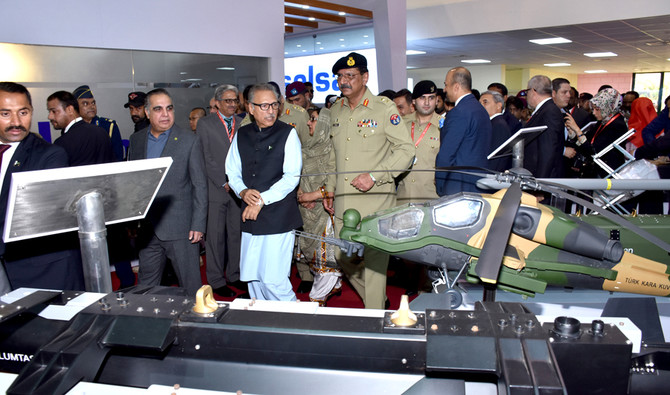KARACHI: In what is being touted as the country’s largest display of arms and arsenal under one platform, Pakistan’s President Dr Arif Alvi inaugurated the 10th edition of the exhibition on Tuesday with an aim to showcase locally-manufactured military hardware and software.
The International Defense Exhibition and Seminar (IDEAS), is taking place at the Karachi Expo Center and will end on Friday.
As part of his inaugural address, Dr Alvi said that “war is not an option because it only causes destruction”, stressing on the fact that Pakistan “is a peaceful country and we want to resolve disputes through dialogues”.
“We kept producing equipment for county’s defense despite adverse conditions,” he said, adding that today, the country “is a proud manufacturer of the JF 17 Thunder and Mushshak aircrafts”.
He reiterated the fact that “our weapons are for peaceful purposes and for defense and not for offense”. “We have a deterrent to ensure that nobody looks at Pakistan with an evil intention,” he said.
Pakistan’s defense industry has now reached the threshold of quality and reliability wherein its products are competing with others in the international market, he said. However, he added, to further excel in this domain there is a need of academia–industry interface, integration of public-private defense industry and involvement of research and development organizations in the defense manufacturing sectors of Pakistan.
“In Naya (new) Pakistan, the government is struggling to secure the economy and offer a suitable environment to investors,” he said while inviting investors to Pakistan which is “the most beautiful country and best destination for business”.
President Alvi also pressed on the need to ensure the economic security of the country. “Security could not be guaranteed unless a country is economically sound and this is the prime responsibility of the government to ensure that Pakistan is a stable economy,” he said.
Highlighting the core regional issue of Kashmir during his speech, he urged India to “come to the negotiating table to discuss regional issues instead of staying away”. “Pakistan looks forward to a resolution of all disputes in a peaceful manner and nations should keep in mind that they cannot oppress people for long,” he said.
The president lamented that despite playing host to more than 3.5 million refugees from Afghanistan, the world has forgotten Pakistan’s contribution to the crisis.
Zobaida Jalal, Federal Minister for Defense Production, said that Pakistan has the potential to emerge as a global platform for defense research, scientific growth, manufacturing, and joint ventures, in order to strengthen our defense capabilities and spur developments as well as exports in the sector.






























